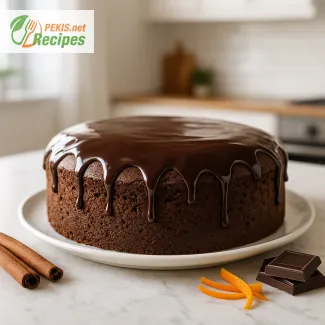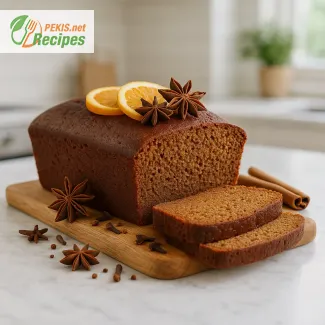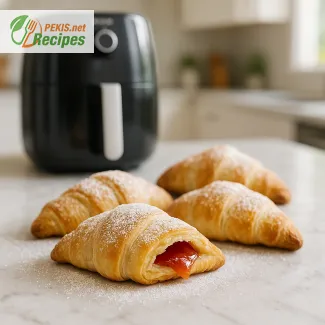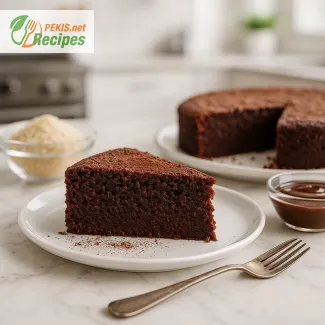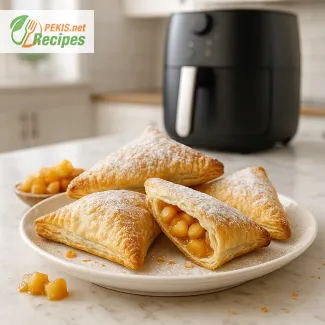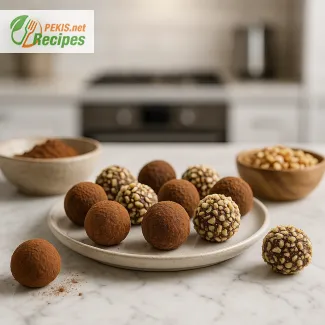Magic Cake (Gâteau Magique) delivers 8 servings of soft, layered perfection in just 20 minutes prep, 50 minutes baking, and 70 minutes total. A single batter of eggs, milk, sugar, butter, and flour transforms into three layers — a dense custard base, creamy center, and light sponge top. Naturally sweet, elegant, and easy to prepare ahead, this French-style dessert keeps for up to 3 days refrigerated, offering a silky, melt-in-your-mouth experience that feels as magical as its name.
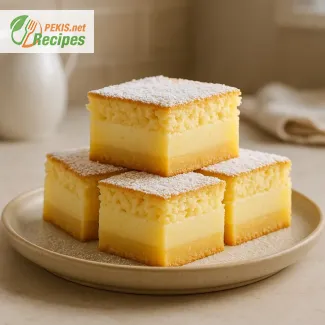
French-Style Magic Cake: The Three-Layer Dessert That Defies Logic
The fascinating transformation of eggs, milk, and butter into a silky French classic
Few desserts capture the essence of culinary alchemy like the Magic Cake, also known by its French name, Gâteau Magique. What appears to be a simple batter of eggs, milk, sugar, flour, and butter transforms in the oven into a dessert with three distinct layers — a soft flan-like base, a creamy custard center, and a light sponge top. This delightful transformation gives the cake its name, as if it were crafted by magic rather than science.
Unlike traditional layered cakes that require multiple steps, the Magic Cake achieves this textural wonder with a single batter. During baking, the liquid ingredients naturally separate, creating a multi-layered structure: the dense custard settles, the airy foam rises, and a tender cake layer forms in between. The result is a visually stunning, melt-in-your-mouth dessert that feels both nostalgic and surprisingly modern.
A brief look into the origin of Gâteau Magique
The Magic Cake traces its roots to French home kitchens in the late 20th century, where it became a symbol of effortless sophistication. Its rise in popularity across Europe came through food magazines and cooking shows that showcased its “magical” transformation. In France, the dessert is often flavored with vanilla, lemon zest, or rum, while modern adaptations embrace chocolate, coffee, or coconut versions. Its unique appeal lies not only in its simplicity but in its perfect balance between texture, flavor, and visual intrigue.
This cake embodies the essence of French pastry philosophy — precision, minimalism, and surprise. It has since gained international fame, appearing in cafés, patisseries, and countless home kitchens under various names: Magic Custard Cake, Impossible Cake, or simply Gâteau Magique.
The structure and texture: culinary science at work
At the heart of this dessert lies a delicate interplay of temperature, density, and timing. The secret of the Magic Cake’s layered structure depends on the precise mixing of beaten eggs and warm milk. When baked at a moderate temperature, the dense egg custard base forms naturally, while the whipped egg whites gently rise to create an airy, golden top.
Each bite offers three sensory experiences in one:
- The bottom layer — rich and velvety like crème caramel.
- The middle layer — creamy, reminiscent of classic vanilla custard.
- The top layer — light, spongy, and delicately sweet.
These contrasting textures make it a perfect dessert for dinner parties or festive occasions, where presentation and taste go hand in hand.
Why you’ll love this Magic Cake
- Simple ingredients, extraordinary results — just a few pantry staples create a complex, elegant dessert.
- Perfect for entertaining — its layered structure impresses guests without requiring professional skills.
- Light yet indulgent — rich in texture but not overwhelmingly sweet.
- Versatile flavor base — easy to adapt with chocolate, citrus, or liqueurs.
- Elegant French charm — brings a touch of Parisian sophistication to your table.
Ingredient synergy: how each element contributes
Each component of the Magic Cake plays a critical role in its transformation:
- Eggs form the structure and define the separation of layers; yolks provide richness, whites create lift.
- Butter adds depth and a smooth mouthfeel, merging flavors into harmony.
- Flour gives gentle body to the batter, allowing the custard to form without turning heavy.
- Milk ensures creaminess and helps regulate baking temperature through moisture retention.
- Sugar and vanilla elevate the aroma and bring the dessert’s delicate sweetness into balance.
This precise equilibrium turns ordinary kitchen staples into a sophisticated French-style dessert worthy of a patisserie window.
Creative variations and modern twists
The adaptability of the Magic Cake makes it a favorite canvas for experimentation. Bakers have reimagined it with diverse flavors and textures, bringing cultural flair to its French roots:
- Chocolate Magic Cake – replaces part of the flour with cocoa for a velvety, bittersweet version.
- Coffee Magic Cake – infuses espresso into the milk for a rich café-inspired dessert.
- Lemon or orange zest Magic Cake – adds citrus brightness that cuts through the creamy texture.
- Coconut Magic Cake – incorporates shredded coconut for tropical fragrance and a subtle crunch.
- Berry-topped Magic Cake – served chilled with fresh raspberries or strawberries for contrast.
Each version highlights the versatility of the original Gâteau Magique, showing that its “magic” lies in both science and imagination.
Storing and making ahead
Magic Cake keeps beautifully when handled with care. Once cooled, it can be refrigerated for up to 3 days, maintaining its layers and silky texture. Cover it tightly with plastic wrap or store in an airtight container to prevent it from absorbing odors.
For a make-ahead version, prepare the batter the night before, refrigerate it, and bake it the next day. The dessert also tastes best after chilling for several hours, allowing flavors to meld and layers to firm up slightly, enhancing its smooth consistency.
The sensory appeal of a timeless dessert
Every forkful of Magic Cake evokes the comfort of home baking combined with the artistry of French patisserie. The contrast of layers, the gentle sweetness, and the cream-custard balance create a multi-dimensional experience that few desserts can match. Its charm lies not only in the surprise of its formation but in the pure satisfaction it brings with each bite — an understated elegance that feels both nostalgic and new.
The Magic Cake (Gâteau Magique) remains a celebration of how simple ingredients, precise technique, and natural chemistry can create a dessert that is nothing short of enchanting.
Years of working with classic French desserts have shown how a few simple ingredients can turn into something extraordinary. This Magic Cake perfectly captures that idea — a recipe where precision and patience reward you with layers that form on their own.
PEKIS – a professional chef and recipe developer with more than 25 years of experience in cooking and baking, specialized in European and international cuisine.
- Preheat and prepare.
Preheat the oven to 160°C (320°F). Line the bottom of a 20×20 cm (8×8 inch) baking pan with parchment paper and lightly grease the sides. - Separate the eggs.
Separate egg whites from yolks into two large bowls. Ensure no trace of yolk enters the whites to achieve a stable meringue later. - Whisk the yolks.
Add sugar to the yolks and whisk until the mixture becomes pale and slightly thickened. Incorporate melted butter and vanilla extract, whisking until smooth. - Add the dry ingredients.
Sift in flour and salt, mixing gently until incorporated. The batter should be smooth and without lumps. - Add milk gradually.
Slowly pour in lukewarm milk while whisking constantly. The mixture will become very thin—this is normal and essential for layer formation. - Beat the egg whites.
Whip egg whites until stiff peaks form. Gently fold one-third of the meringue into the batter using a spatula, then fold in the rest in two additions. The mixture will remain lumpy with visible foam and liquid. - Pour and bake.
Pour the batter into the prepared pan. Bake for 50 minutes until the top is golden brown and slightly firm to the touch. - Cool and set.
Allow the cake to cool completely at room temperature, then refrigerate for at least 2 hours before slicing. Dust with powdered sugar before serving.
FAQ questionWhat makes Magic Cake form three layers from one batter?
The batter is intentionally very thin and relies on density differences during baking. The heavier custard settles at the bottom, the creamier middle sets in the center, and the whipped egg whites rise to create a light sponge top. Gentle folding keeps enough air in the mixture, and a moderate oven temperature lets layers develop without overbaking.
FAQ questionWhich pan size and material give the best result?
A 20×20 cm (8×8 inch) metal or light-colored aluminum pan bakes most evenly. Glass holds heat longer and can cause over-set edges with a too-soft center; if using glass, reduce the temperature by 5–10°C (10–15°F) and extend bake time slightly. Avoid dark nonstick pans that brown the top too quickly.
FAQ questionWhy is my cake rubbery or without distinct layers?
Common culprits are overmixing, too hot an oven, or cold milk that didn’t combine smoothly. Ensure the milk is lukewarm, fold whites gently (streaks and small foam clumps are fine), and bake at 160°C (320°F) until the top is lightly golden and the center barely jiggles. Overbaking drives off moisture and flattens the custard.
FAQ questionCan I make Magic Cake ahead and how do I store it?
Yes—this dessert actually improves after chilling. Cool completely, then refrigerate covered for up to 3 days. Chilling stabilizes the layers and sharpens the custard’s silky texture. Dust with powdered sugar right before serving to avoid absorption.
FAQ questionHow do flavor add-ins affect the layers?
Add liquid flavors (e.g., vanilla, rum, espresso) sparingly to keep the batter pourable but not watery. Dry flavors like cocoa replace part of the flour and can make the structure slightly denser; whisk thoroughly to prevent lumps. Delicate aromatics (citrus zest) lift the custard without altering separation dynamics.
FAQ questionWhat’s the key to beating and folding egg whites correctly?
Whip to firm, glossy peaks—not dry. Fold in three additions using broad, gentle strokes so you retain visible foam; the batter should look lightly mottled with bubbles. A perfectly smooth batter usually means over-incorporation, which reduces lift and blurs the layers.
Magic Cake (Gâteau Magique) continues to enchant because it transforms humble ingredients into something that feels elevated and elegant. Each layer—custard, cream, and sponge—comes together in a way that feels almost impossible, yet completely natural once you understand the science behind it. It’s a reminder that the best desserts often rely on balance, patience, and precision rather than complexity.
This dessert has earned its place as a modern French classic, admired for its texture and versatility. Whether served plain, dusted with powdered sugar, or paired with fresh fruit and whipped cream, its soft structure and subtle sweetness appeal to every palate. The delicate contrast between layers gives it a multi-sensory quality, both visually and in taste.
Beyond its visual beauty, the Magic Cake represents a deeper appreciation for technique and timing. Each element—from gently folding the whites to controlling oven temperature—teaches the fundamentals of baking harmony. Every slice reveals a story of culinary chemistry, turning simple motions into an experience that delights the senses.
It’s a dessert that invites curiosity, creativity, and the pleasure of small details. The smooth custard layer, the airy top, and the melting mouthfeel make it equally suited for a casual gathering or a refined dinner. Once mastered, it opens the door to endless variations—flavored with chocolate, citrus, or coffee—each preserving the same magical structure that made this cake iconic.
The Magic Cake stands as proof that in the kitchen, true wonder comes from simplicity done perfectly.
Allergens present in the recipe:
- Eggs
- Milk
- Gluten (from flour)
Substitution tips:
- Replace all-purpose flour with gluten-free baking flour mix to make the cake gluten-free.
- Substitute cow’s milk with lactose-free milk or almond milk for lactose intolerance (texture may vary).
- Replace butter with plant-based margarine for a dairy-free version.
- Vitamin A: 280 µg – supports vision and immune health.
- Vitamin D: 0.8 µg – aids calcium absorption and bone strength.
- Calcium: 95 mg – essential for bone and dental health.
- Iron: 0.6 mg – contributes to red blood cell formation.
- Potassium: 135 mg – supports muscle and nerve function.
- Magnesium: 12 mg – aids in energy production and enzyme activity.
- Vitamin E: 0.4 mg – protects cells from oxidative stress.
- Selenium: 6 µg – supports immune defense and thyroid health.
- Beta-carotene: 40 µg – precursor of vitamin A, promotes skin and eye protection.
